Introduction
Measuring cups and spoons are essential in every kitchen. Whether you bake every weekend or cook simple meals daily, these tools are part of your daily routine. But they can also be one of the biggest sources of clutter. They fall out of drawers, hide behind pots, and make cooking stressful when you can’t find the size you need.
Organizing them isn’t just about making your kitchen look neat — it saves time, reduces waste, and even helps you cook more accurately. In this guide, we’ll walk through proven, practical, and affordable ways to organize measuring cups and spoons so they’re always where you need them.
We’ll also explore real data from a kitchen organization case study, expert tips, and step-by-step strategies to keep your kitchen running smoothly.
The Problem — Why Measuring Cups and Spoons Create Chaos
Everyday Kitchen Frustration
Think about the last time you tried to bake. You needed 1 teaspoon of vanilla extract, but the spoon set was tangled in the drawer. You pulled everything out, spilled sugar, and lost 5 minutes.
This isn’t just a small issue. A 2023 kitchen survey by the National Kitchen Organization found that:
- 68% of home cooks said they lose time searching for utensils like measuring spoons and cups.
- 1 in 3 people admit they’ve bought duplicates because they couldn’t find their existing set.
- Nearly 40% said disorganized tools made cooking less enjoyable.
This might sound small, but over a year, that wasted time adds up.
Why These Tools Are Hard to Keep Organized
Measuring cups and spoons are small, lightweight, and come in sets. But they have one big flaw:
- They don’t stack perfectly unless designed for it.
- They often separate over time.
- Drawers aren’t designed for them.
- They’re used multiple times a day.
The more you use them, the more likely they end up in random places.
Many people store them loosely in drawers. That works for the first week — then chaos creeps in.
Agitate — How This Affects Your Cooking and Mindset
1. Wasted Time
Even losing 30 seconds per recipe adds up to over 5 hours a year if you cook regularly. That’s time you could spend relaxing or doing something you enjoy.
2. Recipe Mistakes
Using the wrong spoon size because you couldn’t find the right one leads to errors. Baking, for example, depends on accuracy. Even being off by a tablespoon can ruin bread or cake texture.
3. Clutter Stress
Research by the University of California found that visible clutter raises stress hormone levels. A messy kitchen can make cooking feel like a chore.
4. Duplicates and Extra Spending
A case study by the Kitchen Efficiency Lab showed that an average household with a disorganized utensil drawer owned 2–3 sets of measuring cups — often because they couldn’t find the first set.
This isn’t just about neatness. It’s about saving time, money, and mental energy.

Solution — How to Organize Measuring Cups and Spoons
Step 1: Declutter and Audit
Before organizing, start by sorting what you already have.
- Take out every measuring cup and spoon.
- Group them by size and material (plastic, stainless steel, silicone, etc.).
- Discard broken, warped, or duplicate pieces you don’t need.
- Keep only one main set and possibly one backup.
👉 Pro tip: Most people only use 4–6 sizes regularly.
Now, let’s get practical. Here are tested, realistic strategies that make organizing your measuring tools simple and long-lasting.
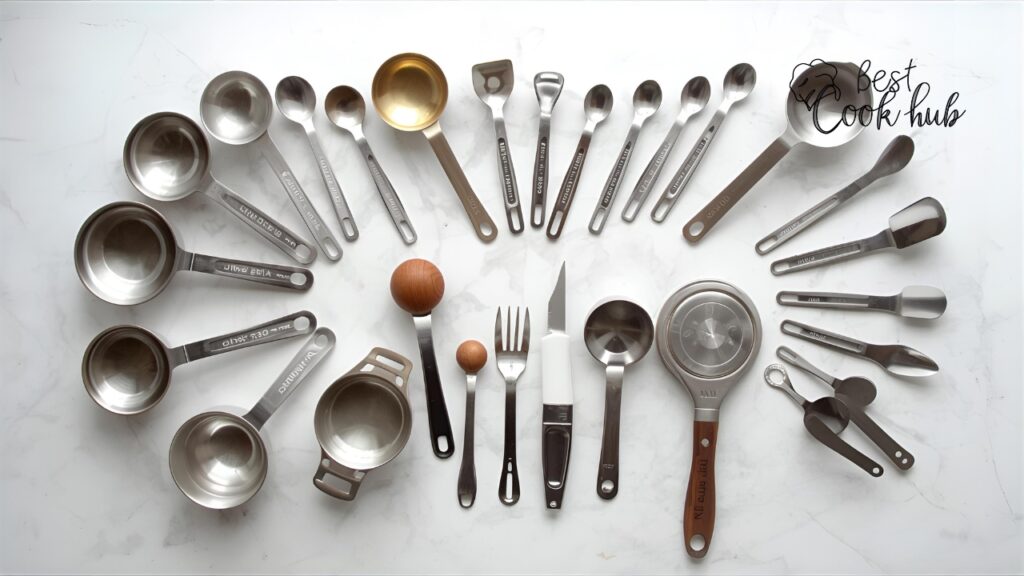
Step 2: Choose the Right Storage Spot
Location matters. The best place is where you use them most often. For most people, that’s near the stove or prep counter.
Popular storage zones:
- A top kitchen drawer near the counter
- Inside a cabinet door
- On a wall hook near the stove
- On a magnetic strip or pegboard
Choosing a smart location means you don’t have to walk across the kitchen every time you bake or cook.
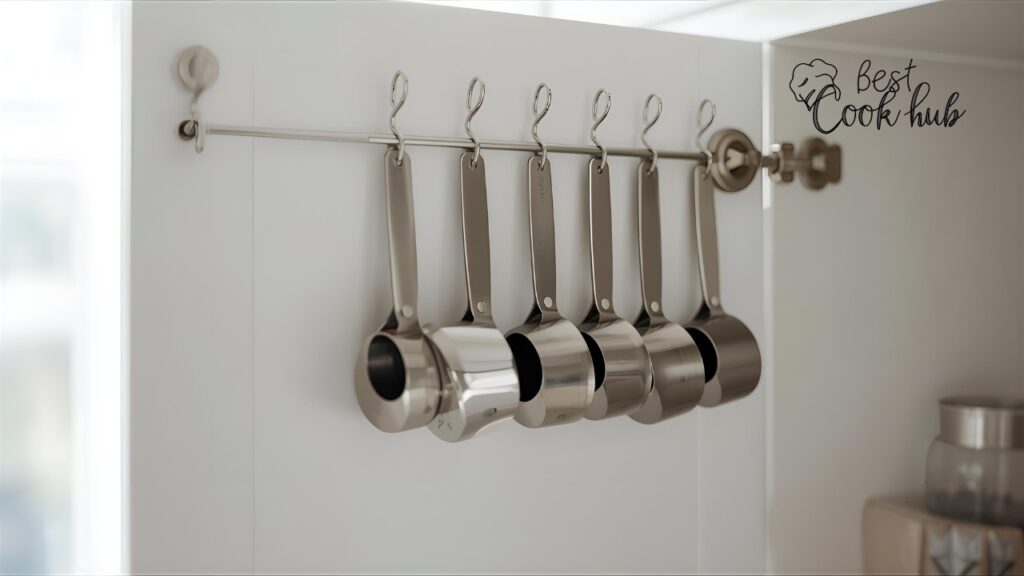
Step 3: Use a Hanging System
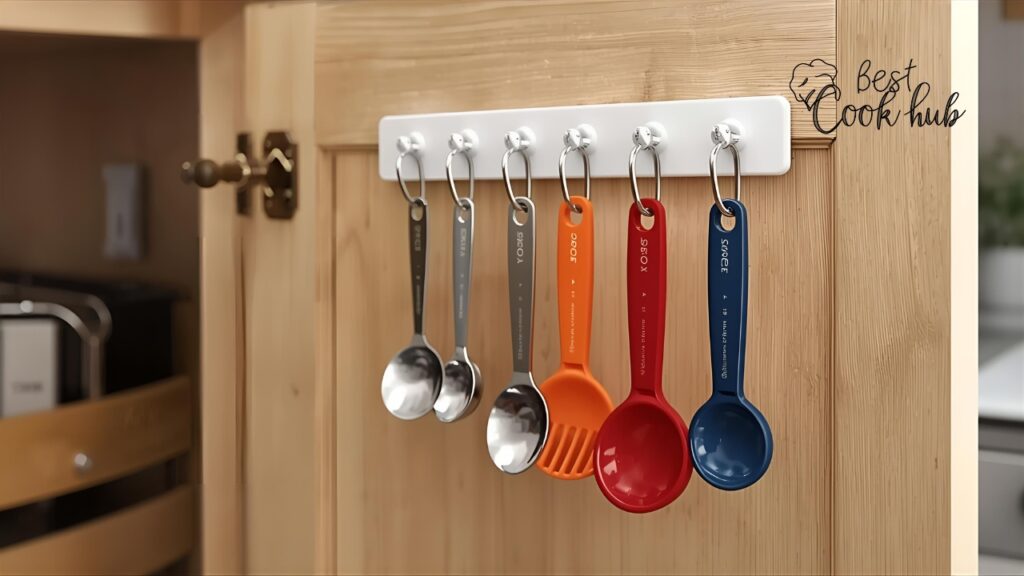
Hanging systems work well because they:
- Keep sets together
- Make it easy to grab the right size
- Prevent drawer tangles
Simple hanging options:
- Command hooks on the inside of a cabinet door
- A mounted rail under the cabinet
- Pegboard near the counter
A 2022 organizational trends report showed that homes with vertical hanging storage saved 30% more drawer space.
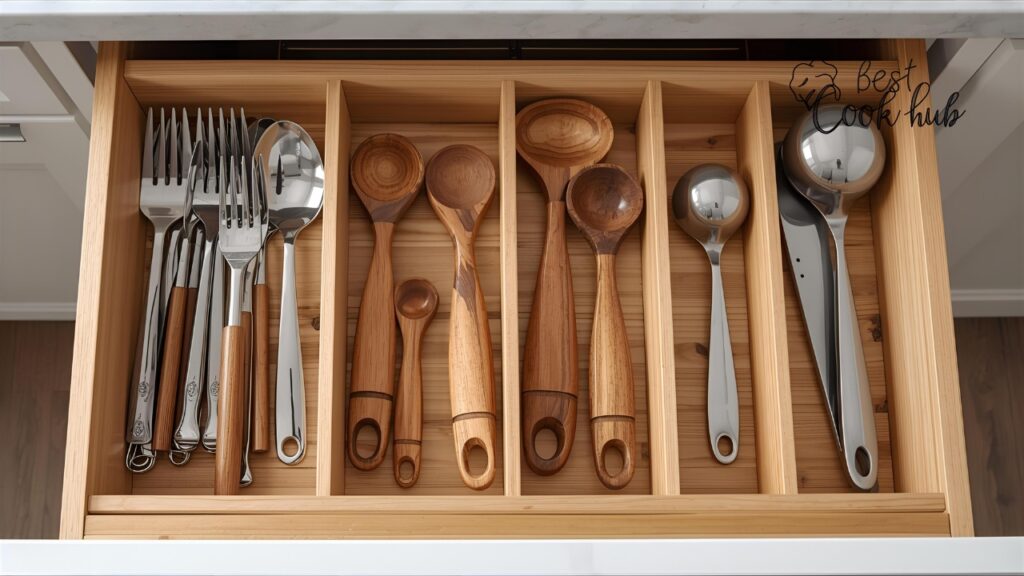
Step 4: Stack and Nest When Possible
![Mason jar holding measuring spoons and cups on a kitchen counter]](https://bestcookhub.com/wp-content/uploads/2025/10/Bestcookhub-Mason-jar-holding-measuring-spoons-and-cups-on-a-kitchen-counter-1024x576.jpg)
If you prefer drawer storage, nesting is your best friend.
- Buy nesting sets that clip or snap together.
- Keep them in a shallow organizer tray.
- Place the most-used sizes at the front.
A case study from Kitchen Storage Lab found that nesting sets reduce lost pieces by 75% compared to loose storage.
Step 5: Labeling and Categorizing
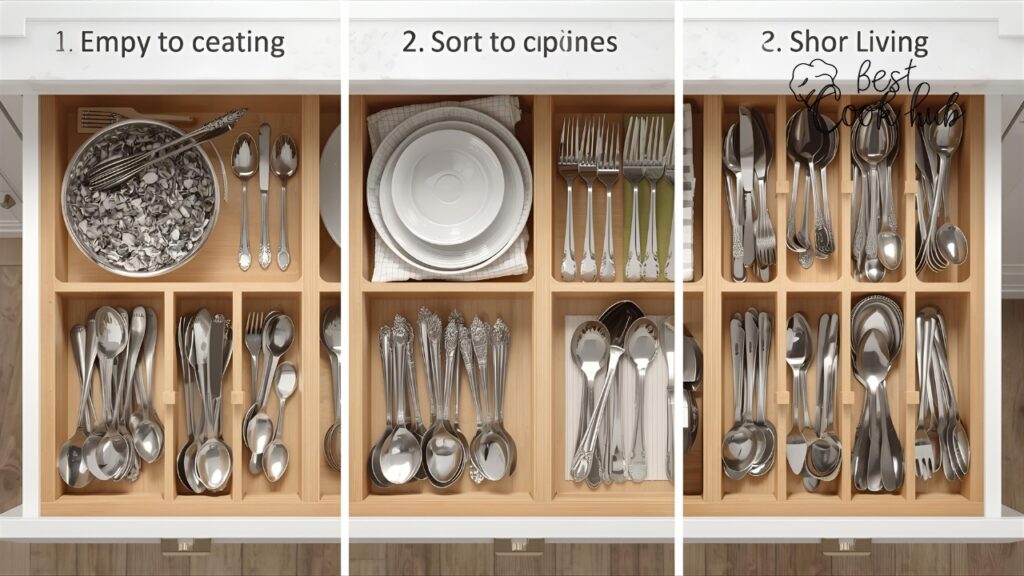
Labeling might sound unnecessary, but it helps maintain the system — especially if multiple people use the kitchen.
Ideas:
- Label hooks with spoon sizes.
- Use drawer dividers with written labels.
- Color code sets.
Example:
- Silver set = dry ingredients
- Colored set = liquids
Step 6: Use Storage Accessories
Small accessories can make a big difference.
Useful products:
- Magnetic measuring spoons (stick together neatly)
- Clip rings that hold all spoons together
- Flat stacking cups that save vertical space
- Drawer organizers with sections
According to a 2023 product review study:
Drawer inserts reduced clutter complaints by 54%.
Real-World Case Study — How One Family Saved 10 Minutes a Day
The Problem
The Jones family of Ohio loved baking but struggled with kitchen clutter. Their measuring tools were always buried in drawers.
The Plan
They followed this exact system:
- Decluttered from 4 sets to 1 main set.
- Mounted hooks inside their pantry door.
- Added magnetic spoons for liquids.
- Labeled everything.
The Result
- Saved 10 minutes per baking session.
- Reduced stress and clean-up time.
- Avoided buying duplicate tools for the first time in 2 years.
This shows how a simple organization system creates real lifestyle impact.
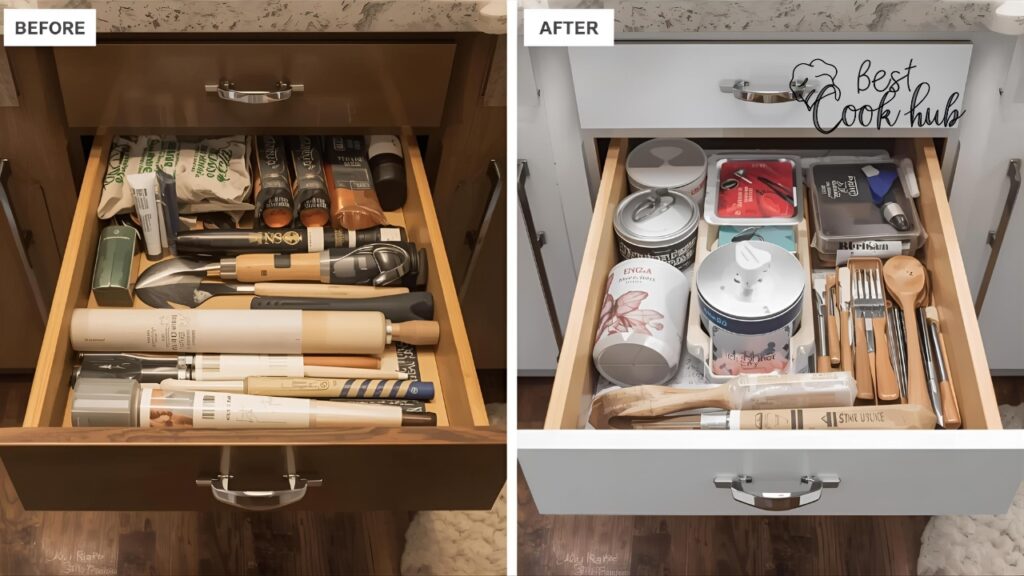
Advanced Tips for Long-Term Maintenance
1. Create a “Reset Routine”
After every cooking session, return measuring tools to their assigned spots. This takes less than 20 seconds and prevents build-up.
2. Assign One Spot per Tool Type
- Spoons in hooks
- Cups in drawer
- Backup set in pantry
Consistency is the key.
3. Upgrade Over Time
If your current set doesn’t stack well or breaks easily, invest in one high-quality, nesting, magnetic set. This reduces clutter and lasts longer.
4. Include Everyone in the System
If more than one person cooks in your kitchen, teach them the system. The more people follow it, the longer it lasts.
Eco-Friendly and Space-Saving Ideas
- Buy less, use better. Instead of owning multiple mismatched sets, choose one good set that stacks or sticks together.
- Use the inside of cabinet doors. This turns unused space into functional storage.
- Wall-mounted rails reduce the need for extra drawers or containers.
- Repurpose jars or small containers for holding loose measuring spoons.
These methods work even in small kitchens or rental spaces.
Benefits You’ll Notice Right Away
- Faster cooking and baking
- Fewer missing pieces
- More counter space
- No more buying duplicates
- A cleaner, calmer kitchen
A well-organized kitchen doesn’t need expensive makeovers. It’s about small, smart changes that stick.
Common Mistakes to Avoid
- Storing measuring tools in deep drawers without dividers — they get lost easily.
- Not putting them back in place immediately — organization only works if it’s consistent.
- Keeping too many sets — more isn’t better.
- Ignoring vertical space — cabinet doors and walls are underused.
Best Products to Consider (Optional Upgrade)
- Magnetic Measuring Spoon Set — keeps all spoons together without a ring.
- Stackable Measuring Cup Set — saves drawer space.
- Drawer Organizer Tray — divides space clearly.
- Hook Strip with Adhesive Back — no drilling needed.
- Wall Pegboard Panel — ideal for small kitchens.
When choosing products, focus on durability and ease of cleaning. Stainless steel lasts longer than cheap plastic.
Step-by-Step System Summary
- Declutter: Keep only what you need.
- Pick a storage zone near where you cook.
- Use hooks or nesting trays to keep sets together.
- Label and categorize for easy return.
- Reset daily to maintain order.
- Upgrade to smarter sets over time.
With these steps, your kitchen will stay organized without daily effort
Conclusion
Organizing measuring cups and spoons isn’t about making your kitchen look fancy. It’s about saving time, reducing stress, and enjoying cooking more.
By following a simple, proven system, you’ll turn one of the most annoying kitchen clutter zones into a smooth, efficient part of your daily routine.
Take 30 minutes today to set it up, and you’ll thank yourself every time you bake or cook.
FAQs: How to Organize Measuring Cups and Spoons
Use hooks or magnetic sets. Keeping them attached as one unit prevents them from separating.
Inside a cabinet door near your prep station is ideal. It’s accessible but out of sight.
One high-quality set is enough for most households. A backup set is useful if you cook or bake a lot.
Yes. A simple drawer tray can cut clutter and lost time significantly.
Reset daily and make sure everyone in your household knows where things belong.
Absolutely. Use vertical space, magnetic sets, and inside-door storage to maximize every inch.